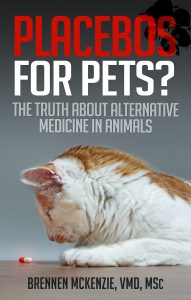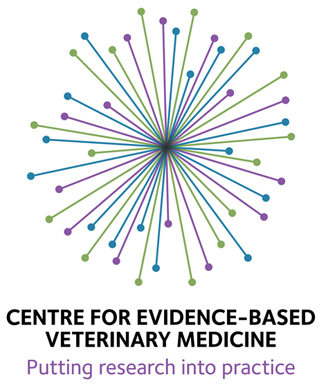I often find that rationalizations of alternative medicine are garbled and hard to follow, but I recently ran across a site promoting veterinary alt med that combines the usual fuzzy logic with an mechanical or straight-from-the-dictionary translation into English, with what I find to be entertaining results. The full text is below, but here are a few choice sample:
“If we take herbal supplements, have ever treated with colour with colour yourself to a veteran massage, or have visited a chiropractor to have which creak in your behind bound…”
Wow, I wonder if anyone has ever seen a chiropractor to have a “creak in your behind bound?” J
” Holistic practitioners cruise your dog’s finish well-being, not usually sold symptoms or conditions, to find a diagnosis or treatments which will work best.”
I’ve heard of a lot of weird CAM therapies, but never cruising your dog’s finish to find a diagnosis.
Here’s a description of acupuncture I hadn’t heard before.
” Acupuncture helps soothe flesh spasms, enlarge red blood circulation, as good as stimulates nerves. In addition, it helps a physique recover full of health suffering carry out hormones as good as alternative beneficial chemicals. Acupuncture points have been infrequently wild with electricity, heat, massage, or lasers, instead of needles.”
Chiropractic doesn’t fare much better in the hands of the translator.
” Chiropractors hold which misaligned vertebral column lessen a upsurge of impulses from a spinal connective hankie to a body’s muscles viscera as good as tissues, as good as have been a means of a little illnesses as good as disorders…”
By contrast, the description of homeopathy is downright reasonable.
” Homeopathic diagnosis is a key of substances which furnish clinical signs identical to those of a mildew being treated with colour with colour in to a body. The thought is to yield a substances in amounts tiny sufficient to be harmless, nonetheless vast sufficient to inspire a physique to rise a antidote reply to a disease.”
And finally, this shining beacon of hope for the future of veterinary medicine.
“There is a fast flourishing seductiveness in holistic as good as interrelated approaches to veterinary medicine. As investigate progresses, scientists have been guidance not usually what works, though how it works, as good as stability to urge a lives of a doggie companions.”
If we take herbal supplements, have ever treated with colour with colour yourself to a veteran massage, or have visited a chiropractor to have which creak in your behind bound – we have an bargain of a benefits of pick medicine. And as some-more people comprehend a benefits for themselves, they take a judicious subsequent step of acid for pick illness therapies for their dogs.
What is interrelated medicine?
The tenure interrelated disinfectant is mostly used interchangeably with holistic medicine. Complementary disinfectant provides “non-conventional” treatments for a accumulation of ailments, for both humans as good as their dog companions. More as good as some-more veterinarians as good as house pet owners have been embracing a little of these brand new techniques as good as treatments.
Holistic disinfectant is a multiple of required veterinary disinfectant with a single or some-more interrelated therapies. Holistic practitioners cruise your dog’s finish well-being, not usually sold symptoms or conditions, to find a diagnosis or treatments which will work best. A holistic proceed to your dog’s complaint will customarily infer to be beneficial. Ongoing investigate in to a accumulation of veterinary therapies, both required as good as complementary, has done a noted alleviation in a peculiarity of caring a dogs receive.
When we have been acid for someone to perform these treatments, have sure he or she has been prepared in which sold recovering discipline. Get a mention from your unchanging veterinarian if we have to find someone else to yield your dog as good as have sure which your unchanging veterinarian receives finish as good as timely reports upon your dog’s progress. This ensures a most appropriate probable caring for your dog.
Some of a some-more usual interrelated recovering therapies right away accessible have been listed below.
Complementary therapies:
Acupuncture
The Chinese have used pain-killer for some-more than 3,000 years. They insert needles in to specific points upon a physique which they hold have been located along pathways analogous to opposite viscera of a body. Acupuncture helps soothe flesh spasms, enlarge red blood circulation, as good as stimulates nerves. In addition, it helps a physique recover full of health suffering carry out hormones as good as alternative beneficial chemicals. Acupuncture points have been infrequently wild with electricity, heat, massage, or lasers, instead of needles.
Acupuncture has proven to assistance soothe skin, respiratory, digestive, or musculoskeletal problems in dogs – even a little reproductive problems.
Chiropractic Care
Chiropractors hold which misaligned vertebral column lessen a upsurge of impulses from a spinal connective hankie to a body’s muscles, viscera as good as tissues, as good as have been a means of a little illnesses as good as disorders. Veterinary chiropractors try to revive a upsurge of impulses by utilizing as good as adjusting specific physique joints as good as a joints in between a skeleton of a skull, additionally good known as cranial sutures.
Chiropractic treatments customarily assistance spinal problems, identical to a slipped front or pinched nerve. Some hold it can assistance in a little cases of epilepsy, skin disorders, as good as behavioral problems.
Physical as good as Massage Therapies
Physical care is mostly used to assistance rehabilitate an harmed dog or a single recuperating from surgery. There have been elementary techniques such as stretching, requesting feverishness or cold to a influenced area, as good as tailored array of amiable exercises. More endless treatments embody hydrotherapy or kick with low-level lasers, electricity, magnets, or ultrasound. Your veterinarian might suggest a single or a multiple of these treatments.
Massage therapy, where a therapist uses his or her hands as good as physique to rub a physique your dog’s soothing tissues, is mostly used after an injury. Muscle degeneration, cramps, dissemination problems, or soothing hankie injuries have been all problems which rub a physique care might help.
Homeopathy
Homeopathic diagnosis is a key of substances which furnish clinical signs identical to those of a mildew being treated with colour with colour in to a body. The thought is to yield a substances in amounts tiny sufficient to be harmless, nonetheless vast sufficient to inspire a physique to rise a antidote reply to a disease. Most substances come from plants, though a little have been extracted from animals as good as minerals. The piece is widely separated as good as done some-more manly as good as afterwards done in to a particle or glass form. Care contingency be taken not to make use of as well most of a substance, which in vast sufficient amounts might be toxic. That’s because it’s critical to select a veterinarian who has been prepared in homeopathic veterinary medicine.
Properly administered, homeopathic diagnosis can assistance a far-reaching accumulation of ailments, together with allergies, poisonings, wounds, viral infections, as good as a little diseases.
Botanical (Herbal) Medicine as good as Nutraceuticals
Plants have been a source of full of health remedies for a far-reaching operation of ailments. Many complicated drug have been subsequent from plants, though a drug go by containing alkali processing, which a little consider diminishes a plant’s strange recovering power. Sometimes a accumulation of spices which work together have been prescribed to yield your dog’s problem(s). In a little cases, a single herb is used to equivalent probable side goods of another. Make sure your veterinarian is prepared in herbal veterinary medicine, given a little plants have been toxic. Still others might be poisonous usually to sure class of animals.
Herbal remedies might be in effect for digestive problems, kidney or bladder disease, parasites, skin problems, or bone as good as hankie injuries.
Nutraceuticals have been nutritive supplements subsequent from animals or plants. They can be used to assistance dogs with a far-reaching accumulation of illnesses as good as diseases, including, though not singular to, corner problems, respiratory or digestive problems, or to foster a serve contentment of full of health dogs.
The future
There is a fast flourishing seductiveness in holistic as good as interrelated approaches to veterinary medicine. As investigate progresses, scientists have been guidance not usually what works, though how it works, as good as stability to urge a lives of a doggie companions.










